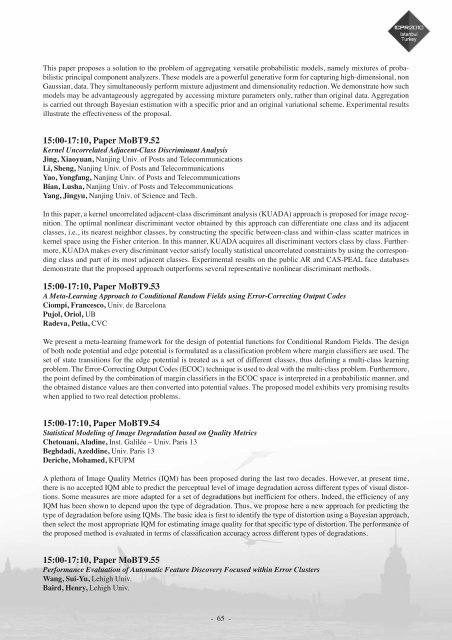Abstract book (pdf) - ICPR 2010
Abstract book (pdf) - ICPR 2010
Abstract book (pdf) - ICPR 2010
- TAGS
- abstract
- icpr
- icpr2010.org
You also want an ePaper? Increase the reach of your titles
YUMPU automatically turns print PDFs into web optimized ePapers that Google loves.
This paper proposes a solution to the problem of aggregating versatile probabilistic models, namely mixtures of probabilistic<br />
principal component analyzers. These models are a powerful generative form for capturing high-dimensional, non<br />
Gaussian, data. They simultaneously perform mixture adjustment and dimensionality reduction. We demonstrate how such<br />
models may be advantageously aggregated by accessing mixture parameters only, rather than original data. Aggregation<br />
is carried out through Bayesian estimation with a specific prior and an original variational scheme. Experimental results<br />
illustrate the effectiveness of the proposal.<br />
15:00-17:10, Paper MoBT9.52<br />
Kernel Uncorrelated Adjacent-Class Discriminant Analysis<br />
Jing, Xiaoyuan, Nanjing Univ. of Posts and Telecommunications<br />
Li, Sheng, Nanjing Univ. of Posts and Telecommunications<br />
Yao, Yongfang, Nanjing Univ. of Posts and Telecommunications<br />
Bian, Lusha, Nanjing Univ. of Posts and Telecommunications<br />
Yang, Jingyu, Nanjing Univ. of Science and Tech.<br />
In this paper, a kernel uncorrelated adjacent-class discriminant analysis (KUADA) approach is proposed for image recognition.<br />
The optimal nonlinear discriminant vector obtained by this approach can differentiate one class and its adjacent<br />
classes, i.e., its nearest neighbor classes, by constructing the specific between-class and within-class scatter matrices in<br />
kernel space using the Fisher criterion. In this manner, KUADA acquires all discriminant vectors class by class. Furthermore,<br />
KUADA makes every discriminant vector satisfy locally statistical uncorrelated constraints by using the corresponding<br />
class and part of its most adjacent classes. Experimental results on the public AR and CAS-PEAL face databases<br />
demonstrate that the proposed approach outperforms several representative nonlinear discriminant methods.<br />
15:00-17:10, Paper MoBT9.53<br />
A Meta-Learning Approach to Conditional Random Fields using Error-Correcting Output Codes<br />
Ciompi, Francesco, Univ. de Barcelona<br />
Pujol, Oriol, UB<br />
Radeva, Petia, CVC<br />
We present a meta-learning framework for the design of potential functions for Conditional Random Fields. The design<br />
of both node potential and edge potential is formulated as a classification problem where margin classifiers are used. The<br />
set of state transitions for the edge potential is treated as a set of different classes, thus defining a multi-class learning<br />
problem. The Error-Correcting Output Codes (ECOC) technique is used to deal with the multi-class problem. Furthermore,<br />
the point defined by the combination of margin classifiers in the ECOC space is interpreted in a probabilistic manner, and<br />
the obtained distance values are then converted into potential values. The proposed model exhibits very promising results<br />
when applied to two real detection problems.<br />
15:00-17:10, Paper MoBT9.54<br />
Statistical Modeling of Image Degradation based on Quality Metrics<br />
Chetouani, Aladine, Inst. Galilée – Univ. Paris 13<br />
Beghdadi, Azeddine, Univ. Paris 13<br />
Deriche, Mohamed, KFUPM<br />
A plethora of Image Quality Metrics (IQM) has been proposed during the last two decades. However, at present time,<br />
there is no accepted IQM able to predict the perceptual level of image degradation across different types of visual distortions.<br />
Some measures are more adapted for a set of degradations but inefficient for others. Indeed, the efficiency of any<br />
IQM has been shown to depend upon the type of degradation. Thus, we propose here a new approach for predicting the<br />
type of degradation before using IQMs. The basic idea is first to identify the type of distortion using a Bayesian approach,<br />
then select the most appropriate IQM for estimating image quality for that specific type of distortion. The performance of<br />
the proposed method is evaluated in terms of classification accuracy across different types of degradations.<br />
15:00-17:10, Paper MoBT9.55<br />
Performance Evaluation of Automatic Feature Discovery Focused within Error Clusters<br />
Wang, Sui-Yu, Lehigh Univ.<br />
Baird, Henry, Lehigh Univ.<br />
- 65 -



